
Riga is the capital and largest city of Latvia and is home to 671,000 inhabitants which is a third of Latvia's population. It is also the largest city in the three Baltic states and is home to one tenth of the three Baltic states' combined population. The city lies on the Gulf of Riga at the mouth of the Daugava river where it meets the Baltic Sea. Riga's territory covers 307.17 km2 (118.60 sq mi) and lies 1–10 m (3.3–32.8 ft) above sea level, on a flat and sandy plain.

Jāņi is an annual Latvian festival. Celebrating the summer solstice. Although astronomically the solstice falls on 21 or 22 June, the public holidays—Līgo Day and Jāņi Day—are on 23 and 24 June. The day before Jāņi is known as Līgosvētki, Līgovakars or simply Līgo.

Jēkabpils is a city in southeastern Latvia roughly halfway between Riga and Daugavpils and spanning the Daugava River. Historic Jēkabpils lies on the left bank, in Selonia while historic Krustpils lies on the right bank, in Latgale. The two cities were united during Soviet rule in 1962 under the Jēkabpils name, but retain their distinct regional character.

Salaspils is a town in Latvia, the administrative centre of Salaspils Municipality. The town is situated on the northern bank of the Daugava river, 18 kilometers to the south-east of the city of Riga.

The Livonians, or Livs, are a Balto-Finnic people indigenous to northern and northwestern Latvia. Livonians historically spoke Livonian, a Uralic language closely related to Estonian and related to Finnish. The last person to have learned and spoken Livonian as a mother tongue, Grizelda Kristiņa, died in 2013, making Livonian a dormant language. As of 2010, there were approximately 30 people who had learned it as a second language.
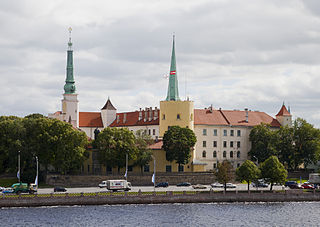
Riga Castle is a castle on the banks of River Daugava in Riga, the capital of Latvia. The castle was founded in 1330. Its structure was thoroughly rebuilt between 1497 and 1515. Upon the castle's seizure by the Swedes, they constructed spacious annexes in 1641. The fortress was continually augmented and reconstructed between the 17th and 19th centuries. Sometime in the 1930s, some renovation work was done by architect Eižens Laube. The Latvian government declared the castle its residence in 1938. Today it is the official residence of the President of Latvia as well as home to several museums.
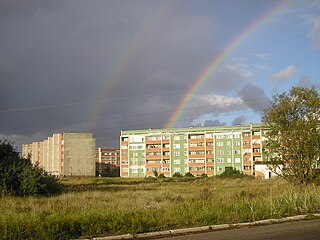
Bolderāja is a neighbourhood of Riga, the capital of Latvia. It is located on the left bank of the Daugava River, in Kurzeme District. Bolderāja probably began as a fishing village. The area has been inhabited since at least the 10th century and possibly for a longer period, however there is no firm evidence because of variations in the course of the Daugava River and the shifting of sand dunes.
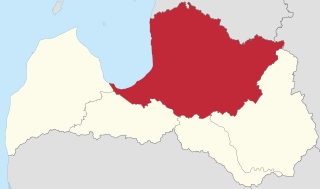
Vidzeme is one of the Historical Latvian Lands. The capital of Latvia, Riga, is situated in the southwestern part of the region. Literally meaning "the Middle Land", it is situated in north-central Latvia north of the Daugava River. Sometimes in German, it is also known as Livland, the German form from Latin Livonia, though it comprises only a small part of Medieval Livonia and about half of Swedish Livonia. Most of the region's inhabitants are Latvians (85%), thus Vidzeme is the most ethnically Latvian region in the country.

Ķengarags is a neighborhood in the city of Riga, Latvia. It is located in the southern part of the city. Ķengarags borders the Daugava River to the west, the Riga-Moscow railway line to the east, Rumbula to the south, and Krasta Residential Neighborhood to the north.

Ikšķile is a town in Latvia, in Ogre Municipality. It was the first capital of the Roman Catholic Bishopric of Livonia, known by the German name of Üxküll. Saint Meinhard, known from the Livonian Chronicle of Henry, was the first bishop of Üxküll. In 1197 Berthold of Hanover, a Cistercian abbot of Loccum, was made the second bishop of Üxküll. Those days the town was the center of the upcoming crusading activities in the Livonian area. Bishop Berthold moved the episcopal see to Riga, but was killed by the Livs in battle.

Riga's Hydroelectric Power Plant is located just beyond Riga's southern border. It is geographically located in the town of Salaspils. Total installed power generating capacity is 402 MW. There are six generators, two transformers and two 330 kV power lines.

Vecrīga is the historical center and a neighbourhood of Riga, Latvia, located in the Central District on the east side of Daugava River. Vecrīga is famous for its old churches and cathedrals, such as Riga Cathedral and St. Peter's Church.

The Riga Marathon is an annual road marathon held in Riga, Latvia, since 1991. It is a member of AIMS and is categorized as a Gold Label Road Race by World Athletics. The marathon starts and finishes near Riga Castle, and runs through Old Riga as well as across the Daugava River. As of 2019, the marathon winner may receive up to 15,000 EUR in prize money, plus a bonus if the distance record is also broken.
FC Daugava Riga is a former Soviet and Latvian football club from Riga. It participated in the Soviet championships. In different years the club represented various Riga factories VEF, railcar building, electro-mechanical.
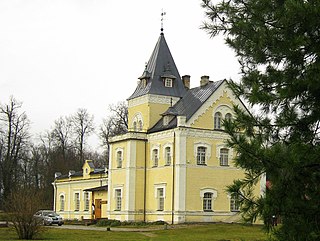
Dole Manor is a manor house on Dole Island in the Daugava River, in the historical region of Vidzeme, in central Latvia, not far from Riga.
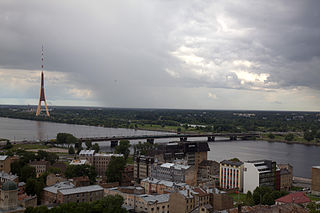
The Island Bridge is a bridge that crosses the Daugava river in Riga, the capital of Latvia. The bridge was built in the period from 1975 to 1977. It was called the Moscow Bridge until 1991. The bridge provides access to Zaķusala and Lucavsala.
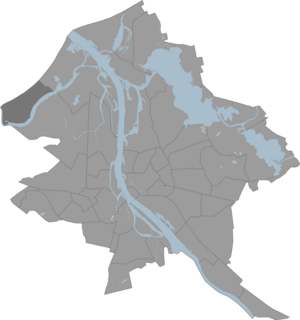
Buļļi or Rītabuļļi is a neighbourhood of Riga, the capital of Latvia. The Western area is known as Vakarbuļļi.
The 2013 Latvian Higher League was the 22nd season of top-tier football in Latvia. FC Daugava were the defending champions. The season started on 29 March 2013.

Lucavsala is an island located on the Daugava River in Riga, Latvia. It has a population of 98.
Valdis Celms is a Latvian artist, graphic designer and neopagan leader. He known for his kinetic art and is one of the leaders of the Baltic neopagan organization Latvijas Dievtuŗu sadraudze.


















